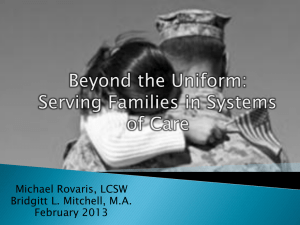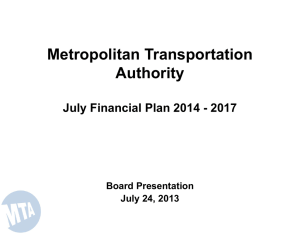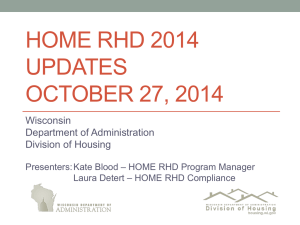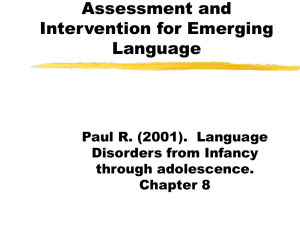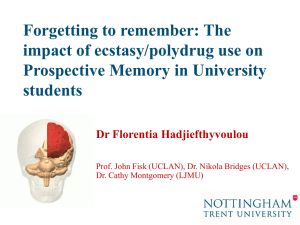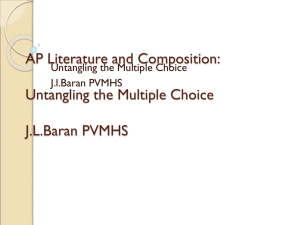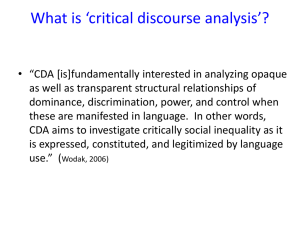Language Disorders of Adults
advertisement
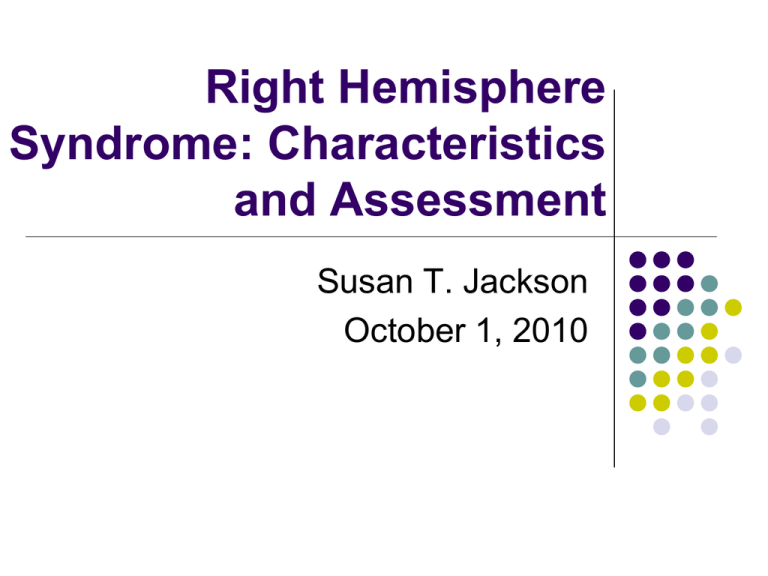
Right Hemisphere Syndrome: Characteristics and Assessment Susan T. Jackson October 1, 2010 Pathophysiology No obvious localization of language or communication in the right hemisphere. Reasons: Gross classification of lesion location (anterior vs. posterior)? More white matter and less gray matter, therefore more intrahemispheric connections between neurons in the right hemisphere? Speculation: complex neuronal networks are necessary for various communicative processes affected in RHD – discourse comprehension; interpretation of humor, affect, sarcasm – damage to networks that integrate info from various sources? Nature and Differentiating Features What is normal vs. abnormal? Boundaries not always clear; consult with family members re: pre- vs. post-stroke behavior in the areas of pragmatics and cognitive abilities Blake (2006) found that “tangentiality, egocentrism, and extremes of quantity (too much or too little) are clinically relevant characteristics of discourse produced by adults with RHD.” That is, these three characteristics were useful in distinguishing healthy older adults from those with RHD. 50% of a nonselect group of those with RHD had verbal communication impairments; 95% of those with RHD in a rehab unit had some type of cognitive or communicative deficit Nature and Differentiating Features May exhibit hyporesponsivity (short answers, lack of facial expression or prosody) or hyperresponsivity (verbose, doesn’t communicate main idea, tells inappropriate jokes) Disorders of attention, visuoperception, and learning and memory are the most commonly diagnosed deficits Problems surface when multiple interpretations are possible and with increased demands on cognitive resources (time constraints, having to generate inferences, and having to consider another person’s point of view) Linguistic, Extralinguistic, and Non-linguistic Deficits Linguistic deficits Least common Includes word-finding difficulty and auditory comprehension deficits most often Extralinguistic deficits Difficulty with figurative language, reduced accuracy of core concepts and inferences, reduced eye contact, reduced sensitivity to emotional prosody, reduced appreciation of shared knowledge, reduced use of prosodic features, reduced ability to interpret humor Nonlinguistic deficits Visual perception problems, left neglect, attention deficits Communication Deficits Figurative/nonliteral language idioms – www.idiomsite.com metaphors (e.g., Her skin is silk) indirect requests – better in natural contexts Impairments in comprehending figurative language could reflect a coarse coding deficit (distant semantic features of words are not activated) – discuss Tompkins’ (2008) info about multiple phases of comprehension (construction phase and integration phase) and about construction and integration deficits Communication Deficits Inferencing http://teach.fcps.net/talk/lesson_display.asp?lessonID=89 Generation and interpretation Difficulty depends on type of inference required (predictions and character emotions are more impaired; context can aid interpretation) Difficulty comprehending when multiple interpretations are possible and/or when an initial interpretation must be revised. Coarse coding deficit hypothesis explanation. Suppression deficit hypothesis (Tompkins) explanation – those with RHD can generate multiple interpretations but have difficulty choosing the most plausible. Difficulty may arise when metacognitive demands are higher (e.g., having to attribute emotions to a character that are at odds with the comprehender’s emotions) Difficulty describing inferentially complex pictures Communication Deficits Discourse organization (macrostructure) Difficulty stating or identifying main ideas Reduced cohesion of discourse production Disorganized discourse Deficits not as apparent when discourse is based on scripts Humor May have a preference for physical, slapstick humor May tell inappropriate jokes (not sensitive to partner or situation) Impairment in the reinterpretation of incongruous info to create coherence between the punch line and the preceding text (similar to difficulties in inference revision). Difficulty choosing an appropriate punch line or explaining why a punch line is funny. Communication Deficits Pragmatics Take fewer turns and talk more about themselves Prolong conversations and don’t heed cues from partner Difficulty using context to interpret an indirect request or a literally false statement (sarcasm or lie) Difficulty detecting tangential statements that block the flow of conversation Theory of mind explanation of pragmatic deficits; RHD pragmatic impairments could be associated with problems associated with multiple interpretations Communication Deficits Prosody Two types: linguistic and emotional/affective prosody Difficulty with comprehension and/or production of affective and/or linguistic prosody (aprosodia). Person with RHD has flat, monotone speech. Difficulty interpreting sarcasm (conflict between linguistic info and prosody). Aprosodia is not a common sequel of RHD (present in ~30% of one RHD sample) See SID-2 article by Leon & Rodriguez (2008) Communication Deficits Affect Hypo- or hyperaffective Difficulty inferring mood from a situation or personality characteristics Person with RHD can make use of context to help interpret emotion May be less effective at verbalizing emotion No clear evidence that RHD impairs negative emotions more than positive ones Attention and Perception Deficits Attention Attention deficits may be due to reduced attentional capacity, difficulty assessing how much attention to allocate, and/or problems with allocating the needed amount of attention There are different types of attention (arousal, vigilance, sustained, selective, divided); there’s more difficulty with having to do two things at once Impaired attention may have a negative impact on comprehension, producing a cohesive narrative Anosognosia = denial of illness Sometimes not outright denial, but reduced awareness of deficits or limitations caused by the deficits May make the person a less than ideal tx candidate Attention and Perception Deficits Neglect – an attentional disorder in which sensory info is not consciously processed by the brain Neglect usually affects the side of space opposite the brain lesion – therefore, left neglect in those with RHD The area that is neglected is not absolute (can be to the left of a person’s midline, to the left of an object, can be affected by presence of other stimuli) Visual neglect is most common and can affect communication – ignore stimuli (people, objects) in left hemispace when having a conversation, miscomprehend written info because do not read left side of page, wide left margins when writing Those with persisting neglect tend to have large lesions There is evidence of unconscious processing of neglected items (house example from text, priming studies) Those with an initial diagnosis of neglect (even if it resolved) had more difficulty with discourse level language tasks than those who never had neglect – because of decreased attention? Attention and Perception Deficits Visuoperception Can cause difficulties in reading and writing (misperceptions of letters and words and disorganized writing) Can cause difficulty on confrontation naming tasks and picture description tasks Prosopagnosia = facial recognition deficit Cognition Sequencing Organizing Problem solving Reasoning Assessment: The Basics Gather medical, biographical, and communicative/cognitive/perceptual data Goals of formal assessment 1. 2. Evaluate communication strengths, weaknesses, and needs When impairments are identified, probe potentially contributing communicative, perceptual, and cognitive factors Published Tests of RHD Communication Impairments Mini Inventory of Right Brain Injury – 2nd edition (MIRBI-2) The Burns Brief Inventory of Communication and Cognition: Right Hemisphere Inventory Rehab Institute of Chicago Clinical Management of Right Hemisphere Dysfunction – 3rd edition (can be purchased for $50 from the RIC book store) Right Hemisphere Language Battery Assessment of Communication: Pragmatics During the interview process you can assess the responses for appropriateness of content, verbosity, paucity of output, tangentiality, egocentrism, irrelevance, turn-taking, eye contact The Pragmatic Protocol (Prutting & Kirshner, 1987) – see handout The Profile of Communicative Appropriateness (Penn, 1987) – see handout Assessment of Communication: Prosody Aprosodia Battery (Ross et al., 1997) – journal article – assesses comprehension and production of prosody (tape-recorded stimuli described; no tape) Battery of Emotional Expression and Comprehension (Cancelliere & Kertesz, 1990) – journal article Florida Affect Battery (Bowers et al., 1998); published by the University of Florida – assesses perception/comprehension of affect and prosody; can be purchased for $200 www.neurology.ufl.edu/forms/fab_manual.pdf Assessment of Communication Figurative/nonliteral language Inferencing Assesses comprehension of idioms, metaphors, and indirect requests (informal) Ask person to describe inferentially complex pictures – score Cookie Theft picture description using Myer’s scoring system (see handout) Use DCT to assess comprehension of discourse – including ability to comprehend implied info Discourse organization Elicit descriptive, narrative, and/or conversational discourse and rate organization of output Assessment of Attention and/or Neglect Behavioural Inattention Test (BIT; Wilson et al., 1987) assesses attention and neglect Test of Everyday Attention (TEA; Robertson et al., 1994) Vigilance – some published computer tasks are available; measure RT and accuracy Selective attention – assess using Stroop Color-Word test http://faculty.washington.edu/chudler/words.html#seffect, feature conjunction tasks (e.g., identify all the red triangles when there are red and black triangles and red and black diamonds) Sustained attention – can be assessed using cancellation tasks or during conversation Divided attention – can be assessed by asking the person to do two things at once (e.g., count while canceling targets on a printed page) Assessment of Attention and/or Neglect Can assess neglect using cancellation tasks, line bisection, drawing a symmetrical item (copying and from memory), describing a picture scene, reading a paragraph, writing a few sentences Look for behaviors such as grooming or dressing one side of the body or bumping into doors/walls on left (could use the Catherine Bergego Scale) that might suggest neglect Assessment of Cognition Reasoning and problem solving Functional Assessment of Verbal Reasoning and Executive Strategies (FAVRES; MacDonald, 2005) Sequencing and organizing Memory Rivermead Behavioural Memory Test – 3rd ed.
